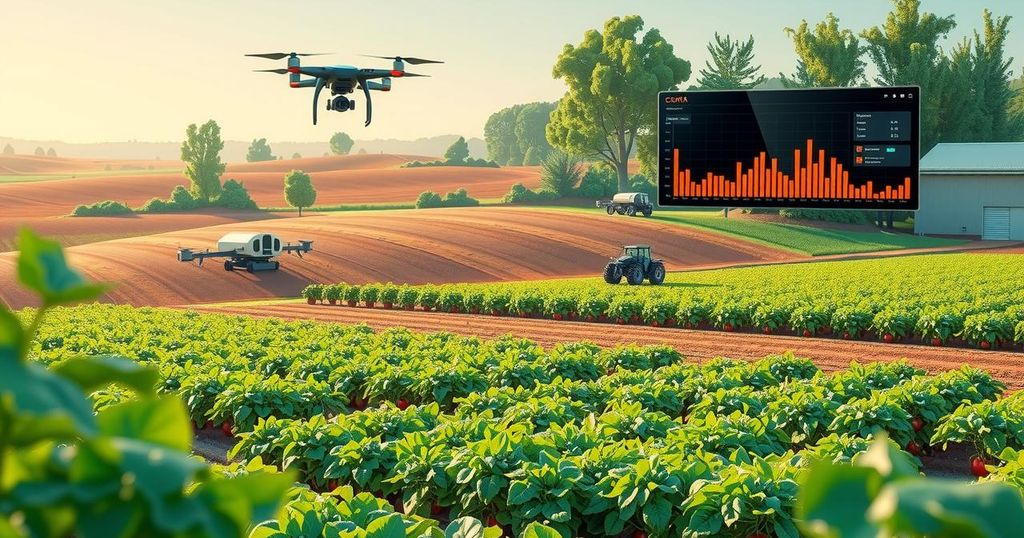Harnessing AI: Transforming Agriculture for Sustainability and Efficiency
This article explores how Artificial Intelligence applications like Machine Learning, Natural Language Processing, Computer Vision, Robotics, Expert Systems, and Reinforcement Learning are transforming agriculture to increase productivity and sustainability despite existing challenges.
Harnessing the potential of Artificial Intelligence (AI) can transform agriculture, making it not only more sustainable but also significantly boosting productivity. This article highlights six essential AI domains that are currently revolutionizing the farming landscape: Machine Learning (ML), Natural Language Processing (NLP), Computer Vision, Robotics, Expert Systems, and Reinforcement Learning.
Machine Learning (ML) allows computers to learn from data without explicit programming. In agriculture, ML is instrumental in yield prediction by analyzing historical data on weather, soil, and crop performance. This predictive capability empowers farmers with insights for planting, pest control, and fertilizer application, optimizing resource use and enhancing yields while adapting to environmental changes efficiently.
Natural Language Processing (NLP) seeks to bridge the gap between human communication and computer understanding. Through virtual assistants or chatbots, farmers can access crucial insights on crop management and pest control in real-time, especially in remote areas. This technology, while beneficial, necessitates human oversight to ensure accuracy and relevance, as many systems require specific agricultural training for optimal output.
Computer Vision empowers machines to understand and analyze visual data, proving invaluable in crop monitoring. AI-powered cameras can scan fields to detect issues like diseases or pests, allowing farmers to act swiftly before problems escalate. This targeted intervention not only saves resources by minimizing pesticide use but also supports sustainable farming practices, enhancing both economic and environmental outcomes.
Robotics represents a visible transformation in agricultural practices. Autonomous robots can execute labor-intensive tasks such as planting, harvesting, and monitoring crops with precision and efficiency. For instance, ongoing research at Penn State is exploring robotic technologies in orchards to automate delicate processes like thinning fruit, ultimately reducing manual labor needs and increasing productivity during peak seasons.
Expert Systems utilize rule-based algorithms to replicate human decision-making for agricultural challenges. These advanced systems assist farmers by offering tailored advice based on current soil and market conditions, enhancing decision-making for crop selection, irrigation, pest control, and nutrient management. The evolution of these systems reflects advancements in computer processing and data availability since their inception in the 1980s.
Reinforcement Learning teaches AI to optimize its actions through environmental interactions, adjusting decisions based on feedback. This technology can streamline resource application, like water and fertilizers, responding dynamically to factors such as soil moisture and plant requirements. By rewarding favorable outcomes and penalizing less effective responses, these systems fine-tune processes, ensuring that crops receive precise care, thereby maximizing yields and conserving resources.
Integrating AI technologies into agricultural practices presents farmers with unparalleled opportunities for precision and efficiency. Yet, challenges such as cost, access, and connectivity continue to hinder widespread adoption. Nevertheless, improving AI applications can lead to more competitive, efficient, and sustainable farming practices.
In summary, the integration of Artificial Intelligence across various agricultural domains is poised to usher in a new era of farming that is more precise, efficient, and sustainable. From Machine Learning predictions and Natural Language Processing interactions to Robotics automating labor and Expert Systems enhancing decision-making, each aspect highlights the transformative potential of AI. While obstacles remain, the advancement of these technologies may propel agriculture toward greater productivity and environmental stewardship.
Original Source: m.farms.com




Post Comment